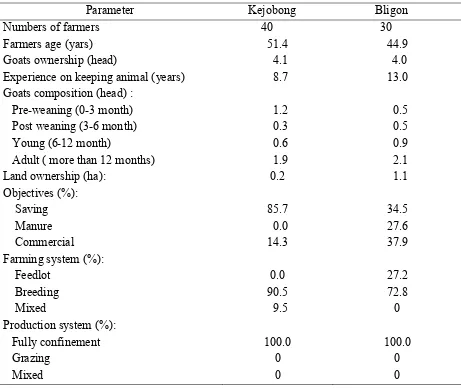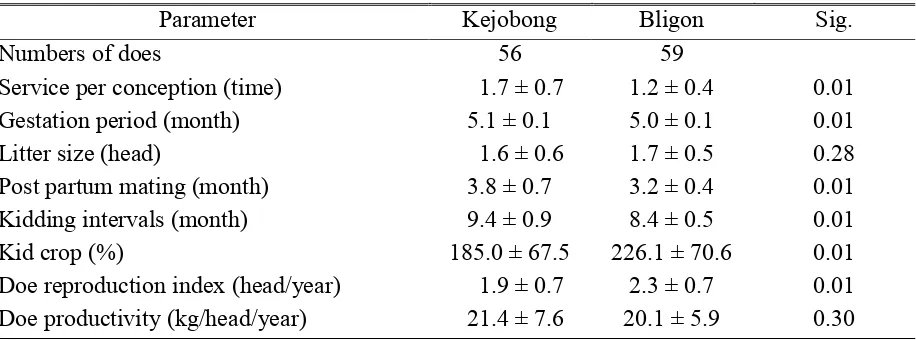1250
The Productivity of Kejobong and Bligon Goats, a Local Indonesian Goats Kept by Farmers
I. G. S. Budisatria1, Panjono1, A. Agus1 and H. M. J. Udo2
1
Faculty of Animal Science, Universitas Gadjah Mada, Yogyakarta, 55281, Indonesia 2
Animal Production Systems Group, Wageningen University, Netherlands
This paper discusses the productivity of Kejobong and Bligon goatskept by farmers at traditional management. One farm research was conducted for 12 months at the two farmers group in Central Java and Yogyakarta Provinces. 70 farmers and their goats were monitored, including services per conception, gestation period, litter size, birth weight, postpartum mating, mortality, weaning weight, average daily gain, kidding intervals, kid crop, doe reproduction index and doe productivity. Service per conception, gestation period and postpartum mating of Kejobong goats was higher (p<0.01) than Bligon goats, while litter size did not significantly differ. Birth weight and pre-weaning mortality of Kejobong and Bligon goats was the same, while weaning weight and average daily gain were significantly higher (p<0.05) in Kejobong kids rather than Bligon kids. Kejobong goats had a potentially better performances in terms of growth, feed intake and feed efficiency compared to Bligon goats, however, poor management in terms of feed quality offered by the farmers make those potential was un-emerged, low reproductive performance of Kejobong does.
Key Words: Kejobong and Bligon goats, Productivity, Farmers
INTRODUCTION
1251
blood profile of Bligon goats were 50% more of Kacang goats. The superiority of local breeds as national germ plasm has not been recognized yet, while its protection or conservation as well as its utilization were still on papers only. It is therefore, protecting, conserving, as well as developing and thinking of utilization of local animals germ plasm need to be supported by certain guidance that can protect the genetic potency of local breed and its family, developed domesticated breed as well as those being kept by subsystem way. This paper presented the productivity of Kejobong and Bligon goats, two local goats kept by farmers in Indonesia.
MATERIALS AND METHODS
The research was conducted for 12 months at the two farmers group; Ngudidadi village, Kejobong sub district, Purbalingga district, Central Java and Purwo Manunggal farmer group, Panggang, Gunungkidul. In total 45 farmers in Ngudidadi and 30 farmers at Puromanunggal were selected and their goats were monitored over a period of 12 months. Ngudidadi farmers group kept Kejobong goats, while Purwo Manunggal farmer group kept Bligon goats. In total, 56 does; 87 pre-weaning kids at Ngudidadi and 75 does; 95 kids in Purwomanunggal, aged 2.0-2.5 years, were regularly monitored. The monitoring includes services per conception, gestation period, litter size, birth weight, postpartum mating, mortality, weaning weight, average daily gain, kidding intervals, kid crop, doe reproduction index and doe productivity. All members of a group were asked specific questions related to their animal condition and farmers characteristics. Goats’ productivity in terms of kid crop, doe reproduction index, and doe productivity over a period of one year were calculated using an equation described by Amir and Knipscheer (1989). Pre weaning kids were observed directly, it was consisted of birth and weaning weight, pre-weaning mortality, and average daily gain.
Productivity was analysed using Independent T-test sample analysis to compare information between Kejobong and Bligon goats, while body sizes, birth weight, weaning weight and daily gain of goat were analysed using 2x2 factorial analysis with sex and breed as factor. The characteristics of the farmers was presented in percentages and analysed descriptively.
1252
way to gain cash money, therefore they perceived that keeping goats could as a kind of commercial activity.
RESULTS AND DISCUSSION
Ownership and objective of keeping goats
Tabel 1. Characteristics of Kejobong and Bligon goats farmers
Parameter Kejobong Bligon
Numbers of farmers 40 30
Farmers age (yars) 51.4 44.9
Goats ownership (head) 4.1 4.0
Experience on keeping animal (years) 8.7 13.0
Goats composition (head) :
Pre-weaning (0-3 month) 1.2 0.5
Post weaning (3-6 month) 0.3 0.5
Young (6-12 month) 0.6 0.9
Adult ( more than 12 months) 1.9 2.1
Land ownership (ha): 0.2 1.1
Objectives (%):
Saving 85.7 34.5
Manure 0.0 27.6
Commercial 14.3 37.9
Farming system (%):
Feedlot 0.0 27.2
Breeding 90.5 72.8
Mixed 9.5 0
Production system (%):
Fully confinement 100.0 100.0
Grazing 0 0
Mixed 0 0
Doe productivity
1253
Tabel 2. Productivity of Kejobong and Bligon does kept by farmers
Parameter Kejobong Bligon Sig.
Numbers of does 56 59
Service per conception (time) 1.7 ± 0.7 1.2 ± 0.4 0.01
Gestation period (month) 5.1 ± 0.1 5.0 ± 0.1 0.01
Litter size (head) 1.6 ± 0.6 1.7 ± 0.5 0.28
Post partum mating (month) 3.8 ± 0.7 3.2 ± 0.4 0.01
Kidding intervals (month) 9.4 ± 0.9 8.4 ± 0.5 0.01
Kid crop (%) 185.0 ± 67.5 226.1 ± 70.6 0.01
Doe reproduction index (head/year) 1.9 ± 0.7 2.3 ± 0.7 0.01 Doe productivity (kg/head/year) 21.4 ± 7.6 20.1 ± 5.9 0.30
Reproductive performance is one of the main determinants of productivity of small ruminants (Mellado et al., 2006). Female Bligon goats had a better reproductive performances than female Kejobong goats, therefore it has a higher percentages on kid crop and higher doe reproduction index. On average, kid crops and doe reproduction index of female Bligon goats was more than 20% higher than female Kejobong goats. Reproduction efficiency is determined by many different processes and these processes include age at first kidding, kidding interval, birth type and the litter sizes at birth and the weaning rate (Greyling, 2000), the ability to breed does at a given period that will fit a specific market demand, therefore, controlling reproduction of goats is necessary to group kidding over a limited period of time and also to facilitate nutrition adjustments in relation to the physiological stage and lactation needs of batches of animals (Fatet et al., 2011). The management system, which includes the nutritional requirement and rearing environment, can affect reproductive performance considerably (Song et al., 2006). Improved feeding significantly reduced the age at puberty of female kids (Chentouf et al., 2011). Litter size and gestation period resulted on this study, however is in line with the previous study of local goats in Morocco (Chentouf et al., 2011) and Mexico (Urdaneta et al., 2000).
Pre-weaning growth
1254
Tabel 3. Average of birth weight, weaning weight and daily gain of Kejobong and Bligon
kids
Parameter Kejobong Bligon
Male Female Male Female
Birthweight (kg) ns 2.2±0.06 2.1±0,06 2.2 ± 0.23 2.1 ± 0.19 Weaning weight (kg) 11.4±0.31a 12.0±0.98a 8.3 ± 1.32 b 7.8 ± 1.23 b ADG (g/head/day) 99.5±3.17 a 107.0±9.78 a 75.7 ± 20.92 b 64.5±18.13 b Pre-weaning mortality
(%)ns
7.3 6.7
a,b
Different superscript at the same rows denote significant differences (P<0.05).
Poor performances of female Kejobong goats was not so in their kids. Kejobong kids had a better pre-weaning performance than Bligon kids in terms of weaning weights and average daily gain. Less litter size and high pre-weaning mortality of Kejobong goats might be affect the growth of pre-weaning kids. Marai et al. (2002) found that the productivity of goats born as singles was higher than those of twin and multiple births. The less litter sizes and high mortality rate, causing low numbers of still birth kids at pre-weaning, less competitiveness between kids for milking, therefore kids had opportunity to maximise their growth during pre-weaning ages, so average daily gain and pre-weaning weight was also high.
Overall, Bligon goats’ farmers seem to manage their small ruminants better than Kejobong
goats’ farmers. Kejobong goats farmers offered cassava leaves as main feed for their goats
combined with native grass, while Bligon goats farmers offered variuos type of local forages which can be easily found in their surroundings, since most of them are living in the forest side. Budisatria et al. (2010) found that abundant tree leaves are available surrounding the farmers, primarily farmers who live close to forest areas, and often they integrate their annual crops with legume trees, which function as a fence and provide feed for small ruminants. It is well recognized that the nutritional status of animals influences their reproductive performance (Lassoued et al., 2004; Melaku et al., 2004), nutritional strategies can also modulate the oestrous cycle and affect reproductive performances (Fatet et al., 2011).
1255
REFERENCES
Amir, P. and H.C. Knipscheer. 1989. Conducting On Farm Animal Research: Procedures and Economic Analysis. Winrock Int. Inst. Agric. Dev. And Ltn Dev. Res. Centre. Singapore National Printers Ltd., Singapore.
Anderson, S., and R. Centonze, 2007. Property rights and the management of animal genetic resources. World Develop. 35(9):1529-1541.
Budisatria, I. G. S. 2006. Dynamics of small ruminant development in Central Java Indonesia. Ph.D. Thesis. Wageningen Agriculture University, Wageningen, The Netherlands, 144 pp.
Budisatria, I.G.S., H.M.J. Udo, C.H.M. Eilers dan A.J. van der Zijpp, 2007. Dynamics of small ruminant production: A case study of Central Java, Indonesia. Outlook on Agriculture 36(2):145-152.
Budisatria, I.G.S., H.M.J. Udo, A.J. van der Zijpp, E. Baliarti, T.W. Murti. 2008. Religious Festivities and Marketing of Small Ruminants in Central Java. Asian J. Agric. Develop. 5(2):57-74.
Budisatria, I.G.S., H.M.J. Udo, C.H.A.M. Eilers, E. Baliarti, A.J. van der Zijpp. 2010. Preferences for sheep or goats in Indonesia. Small Rumin. Res. 88:16-22. Chentouf, M., J.L. Bister , B. Boulanouar, 2011. Reproduction characteristics of North
Moroccan indigenous goats. Small Rumin. Res. 98:185-188.
Fatet, A., M.T. P. Rubio, B. Leboeuf. 2011. Reproductive cycle of goats. Anim. Reprod. Sci. 124:211-219.
Greyling, T.T.C., 2000. Reproduction traits in the Boer goat doe. Small Rumin.Res. 36:171– 177.
Lassoued, N., M. Rekik, M. Mahouachi, M. Ben Hamouda, 2004. The effect of nutrition prior to and during mating on ovulation rate, reproductive wastage, and lambing rate in three sheep breeds. Small Rumin. Res. (52):117–125.
Marai, I.F.M., E.L. AbouFandoud, A.H. Daader, A.A. AbuElla. 2002. Reproductive doe traits of the Nubian (Zaraibi) goats in Egypt. Small Rumin. Res. 46, 201–205.
Melaku, S., K.J. Peters, A. Tegegne, 2004. Feed intake, live weight gain and reproductive performance of Menz ewes supplemented with Lablab purpureus, graded levels of Leucaena pallida 14203 and Sesbania sesban 1198. Livest. Prod. Sci. (87):131–142. Mellado, M., R. Valdez, J.E. Garcia, R. Lopez, A. Rodriguez 2006. Factors affecting the
reproductive performance of goats under intensive conditions in a hot arid environment. Small Rumin. Res. 63:110-118.
Song, H.B., I.H. Jo, H.S. Sol, 2006. Reproductive performance of Korean native goats under natural and intensive conditions. Technical Note. Small Rumin. Res. 65:284-287. Urdaneta, L. D., G. T. Hernandez, C. B. Perez, F.G. Cossio, M.O. Arce, O.G. Betancourt,

